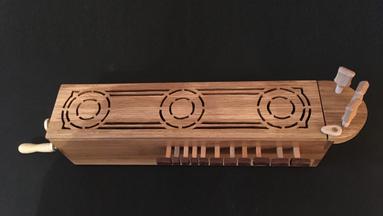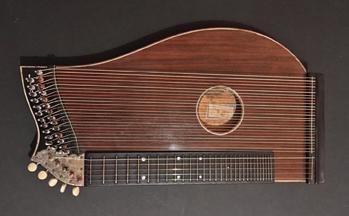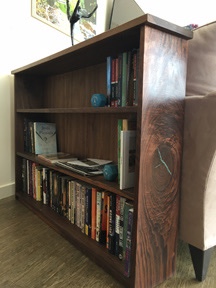After nearly two years, the Santa Cruz County Open Studios Art Tour is back! This will be my 20th year opening my studio to the public. I am listed in the Artist Guide as Artist #253 and will be open from 11 to 5 on October 9-10 and 16-17. A preview exhibit is opening at the Santa Cruz Art League on First Friday, October 1.
What will be different this year is that my exhibit will be outside only and next to my studio. (Hopefully the rains will hold off!) The Arts Council is also suggesting visitors wear masks when visiting artist’s studios. They have given artists a set of masks to give out if necessary.
I have several new pieces to show, and I hope to see you here on the second and third weekends in October.
Because there was no Open Studios in 2020, the Arts Council created the Visual Arts Network. It is still active online and is a good place to see the works of other Open Studios artists.
New Work
A few months ago a customer from Oregon wanted me to build her a dulcimer cane. I had built two of them before, and one sold, but, unfortunately, one was stolen from a gallery showing. My customer had seen the one I sold on Etsy, and she wanted one similar. She uses a cane, and I asked her how high it was. I built her dulcimer cane to the same height. This one has a maple body with salvaged black walnut handle and fingerboard.
There is also salvaged ebony for accents. It has a very bright tone.
While making this commissioned piece, I decided to make a second similar one but with a different carving and several inches taller. It is made with the same woods.
I finished it around two weeks after completing the commission and put it up for sale on Etsy.
That didn’t last long. It was on Etsy for barely 10 days and sold. It’s going to a new home in Colorado.
Other instruments that have been very popular this last year are the Saxon and Germanic Lyres (Rotes), both full sized and the smaller “mini” sizes. Because of the popularity, I had to make a few more.They are also on Etsy.
One of the newest instruments I crafted is the Mbira, also known as an African thumb piano. The first one I built sold on Etsy right away, so I made a second. It also sold right away. So, I made another. This one is salvaged mahogany sides and back, salvaged first-growth Douglas fir top, flamed maple binding, and a black walnut and maple soundhole. Like the other Mbiras I made, it has a bright lovely tone. It is available on Etsy.
There are several pieces I’m currently working on. Lately, I’ve been working a little more on my Ottavina (Octave Spinet). I added some old-style hinges to the key cover and the top. I also made a post for holding the lid up. (Like a top on a grand
piano.) The next “big” project is to layout for the strings, then make a rail for the jacks (plectrum) that will pluck the strings. I originally started work on this octave spinet (which is a type of harpsichord) back in the mid to late 1970s. The case I built then was not up to my standards today. I made a new case of black walnut using angled dovetails. The stand is also black walnut.
On my workbench are parts for another teardrop-style dulcimer. Once again the woods are salvaged. The top, back, and sides are cocobolo, which is a Central American tree. I’m about ready to carve the head and tailpiece, which are hard maple. Once I finish carving, assembly will go fairly quickly. The whole process takes around 20 hours or so over two to three weeks.
In addition to my studio, I have a shop in my garage where I have my large power tools, like my table saw, 17 inch band saw, drum sander, spindle sander, and a large belt and disk sander. This is where I work on larger pieces and do antique stringed instrument restorations.
A project I’m working on now is a small pipe organ. It’s mostly maple and some black walnut. The pipes are pine and oak. I hope to have it finished in a couple of weeks so I can enter it in the 12 x 12 (x 12) event at the Cabrillo College Gallery later in October.
Recently I was watching a virtual American Woodturners Association Zoom-type broadcast of a woman woodturner who used power carving devices for embellishing turned vessels. One of her power carving tools was a high speed device that seemed to cut through the wood like butter. She swore by it. I had to have one.
After some research, I finally found the carver at an online storefront. As the woman woodturner said, it does cut through wood like butter. My Foredom and Dremel with flex shafts run up to 15,000 rpm. My new Marathon III Micromotor runs over 30,000 rpm allowing me to make highly detailed carvings. What is also nice about the Marathon is the handpiece has a quick change feature. Extremely easy to change bits. No wrenches needed!
Restorations
Since my last blog, I’ve restored three more zithers. Two were German made concert zithers, and one was a U.S. made chord zither.
This one is a Circa 1900-1910 Job. Bartholomä Concert Zither. Bartholomä has been used as a last name in Germany, especially the Bavarian region, but now is more commonly spelled Bartholomew. Bartholomä is also a small town in the hills east of Stuttgart and southwest from Nurenberg. It’s very possible this zither could have been made in Nurenberg, which was a major center of concert zither manufacturing in the late 1800s to just before WWI. Stuttgart also has had some zither manufacturers but is now an industrial city where Mercedes and Porsches are made. Read my repair log here.
This larger one is a Circa 1903-1917 August Schulz Concert Zither. Because of the size, it was sometimes called an Alpine zither or a harp zither. This fine zither was crafted in Nuremberg, Germany by August Schulz. What I could find from my research was that the workshop was in operation from 1902 to 1917. Operations probably ceased because of World War I. There were actually more August Schulz guitars made than zithers. August Schulz also made lutes. Read my repair log here.
This chord zither on the right is a Circa 1900 Home Educational Co. Mandolin Guitar-Harp. Of course, this is not a mandolin or a guitar. It is closer to a harp because it is plucked.
Chord zithers, often called Guitar Zithers, were extremely popular from the late 1800s to the mid-1900s. Hundreds of thousands were made by several companies, including Friederich Menzenhauer, Oscar Schmidt, and Phonoharp. Phonoharp, of East Boston, Massachusetts, made several different models of chord zither, each one manufactured in the thousands. These were primarily sold in Sears and Montgomery Ward catalogs as well as door-to-door. Some Phonoharp models, called Mandolin Guitar-Harps, were distributed by the Home Educational Company of Concord, North Carolina, who applied their own labels inside the instruments.
This zither need extensive work to restore it. You can read my repair log on my website.
Do you have a zither or other stringed instrument needing restoration or repair? Is is a family heirloom you want to play and/or save for posterity? If you do, send me an email, along with photos or the instrument (especially problem areas on the instrument), so I can give you a quote on my services. My email is ron@roncookstudios.com.
That’s it for now. Remember, Open Studios is coming up. My studio is open 11-5, October 9-10 and 16-17. See you then!


 This is the third of my popular "Cantigas de Santa Maria" symphonies. It is made of white oak with maple pegs, tangents (button keys), wheel and handle. The soundboard is 100+ year old salvaged first-growth Douglas fir. The tangent ends are black walnut. The bridge is laminated salvaged ziracote. The handle shaft that turns the wheel runs into the box through the wide-open mouth of a character's face that I carved out of a tagua nut. It has two melody strings and two drones.
This is the third of my popular "Cantigas de Santa Maria" symphonies. It is made of white oak with maple pegs, tangents (button keys), wheel and handle. The soundboard is 100+ year old salvaged first-growth Douglas fir. The tangent ends are black walnut. The bridge is laminated salvaged ziracote. The handle shaft that turns the wheel runs into the box through the wide-open mouth of a character's face that I carved out of a tagua nut. It has two melody strings and two drones. Before I completed my 50th anniversary dulcimer, I finished another I had in the planning stage for several years, a resonator dulcimer. The 5 inch "paint lid" resonator is hand-spun aluminum and has a biscuit bridge similar to the National Guitar style. This one is 28 inches from nut to bridge. The body is several inches longer than my traditional dulcimers and a little thicker. The resonator and the large "box" size give this dulcimer a very interesting and lovely sound.
Before I completed my 50th anniversary dulcimer, I finished another I had in the planning stage for several years, a resonator dulcimer. The 5 inch "paint lid" resonator is hand-spun aluminum and has a biscuit bridge similar to the National Guitar style. This one is 28 inches from nut to bridge. The body is several inches longer than my traditional dulcimers and a little thicker. The resonator and the large "box" size give this dulcimer a very interesting and lovely sound. This year started out with a restoration of a lovely German concert zither that was made sometime in the 1920's by Aug. Richter, who belonged to a family of instrument makers in Munich.
This year started out with a restoration of a lovely German concert zither that was made sometime in the 1920's by Aug. Richter, who belonged to a family of instrument makers in Munich.


